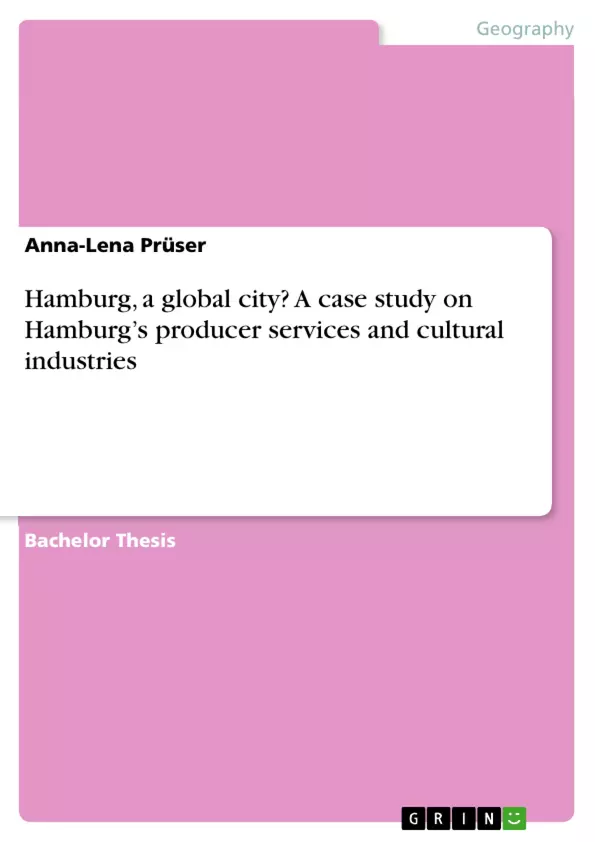This bachelor thesis examines a city’s interlinkage in the globalizing processes and aims at answering the research question: To what extent can Hamburg be qualified as a Global City in terms of its localization of global producer services and cultural industries? Global cities are defined as local nodes of the corporate service sector and the cultural economy, which are associated in a global network. Following this, an in-depth analysis of Hamburg’s performance on the economic and cultural dimension will be provided in order to clarify its global city status. It will be innovative in two respects: Firstly, it will provide an incorporation of both dimensions (economic and culture) into its analysis in order to provide a more comprehensive and less biased estimate of a metropolis’ global city status, a practice that has not been conducted in the literature so far. Secondly, it will apply this dualistic approach to the city of Hamburg. Even though it is the second largest city in Germany (according to population numbers), Hamburg has not yet been subject of detailed investigation by global city researcher. In a SWOT-analysis the strength, weaknesses, opportunities and threats of the producer service sector and the cultural economy are outlined in order to determine their basic situation; the sectors’ integration in the global networks are discussed mainly on basis of the Globalization and World Cities Studies Research Network (GaWC) dataset and the data generated by Kratke (2010). By linking the local conditions with the global perspective on both sectors, the not fully developed functional status of Hamburg as a global city becomes clear; it is a global city ‘in the second row’. Derived from this finding, recommendations for a better involvement in the global networks are provided.
Inhaltsverzeichnis (Table of Contents)
- I. Abstract
- II. List of tables
- III. List of figures
- III. List of abbreviations
- 1. Introduction
- 2. Theoretical Framework
- 2.1. Global City and World City Research
- 2.2. Economic features
- 2.2.1. World Cities
- 2.2.2. Global Cities
- 2.3 Global Cities and culture
- 2.4. Working definition and research questions
- 3. Methodology
- 3.1. Research design
- 3.2. Data collection
- 3.3 Method of data analysis and operationalization
- 3.4 Concluding remarks
- 4. Analysis
- 4.1 SWOT-analysis of the producer service sector
- 4.2. How global is Hamburg's producer service sector?
- 4.3. From analysing the local corporate service sector to its global connectivity
- 4.4. SWOT-analysis of the cultural economy
- 4.5. How global is Hamburg's cultural economy?
- 4.6. From analysing the cultural economy in Hamburg to its global connectivity
- 4.7. The corporate service sector and the cultural economy compared
- 5. Conclusion
- 6. Recommended action
- 7. Limitations and further research
- 8. List of References
- 9. Appendix
- The analysis incorporates both economic and cultural dimensions to provide a comprehensive and less biased assessment of a city's global city status, a novel approach in the literature.
- It investigates the global city status of Hamburg, a major German city that has not been subject to extensive research in this field.
- The study uses a SWOT-analysis to examine the strengths, weaknesses, opportunities, and threats associated with the producer service sector and the cultural economy.
- It explores the integration of these sectors within global networks, relying primarily on data from the Globalization and World Cities Studies Research Network (GaWC) and Kratke (2010).
- The thesis aims to clarify Hamburg's functional status as a global city by comparing its local conditions with global perspectives on both sectors.
Zielsetzung und Themenschwerpunkte (Objectives and Key Themes)
This bachelor thesis explores the interconnectedness of a city within the globalizing processes. Its main aim is to determine whether Hamburg can be considered a Global City based on its localization of global producer services and cultural industries. Global cities are defined as key locations within the global network, characterized by their concentration of corporate service sectors and cultural economy.
Zusammenfassung der Kapitel (Chapter Summaries)
The first chapter introduces the research question and context, highlighting the increasing concentration of economic and cultural activities in cities due to globalization. The theoretical framework in the second chapter delves into the concepts of global and world cities, examining their economic and cultural characteristics. The chapter also outlines the research question and working definition of global cities.
The third chapter focuses on the methodology used, including the research design, data collection, and analysis methods. The fourth chapter presents a detailed analysis of the producer service sector and the cultural economy in Hamburg, utilizing a SWOT-analysis and data from the GaWC and Kratke. It evaluates their integration within global networks and assesses Hamburg's overall global connectivity in both sectors.
Schlüsselwörter (Keywords)
The primary focus of this thesis is the concept of global cities, specifically examining Hamburg's status as a global city. It delves into the key sectors contributing to a city's global city status, namely producer services and cultural industries. The research relies on data from the Globalization and World Cities Studies Research Network (GaWC) and Kratke (2010), highlighting their importance in understanding the global network connectivity of cities.
- Arbeit zitieren
- Anna-Lena Prüser (Autor:in), 2015, Hamburg, a global city? A case study on Hamburg’s producer services and cultural industries, München, GRIN Verlag, https://www.grin.com/document/445271



